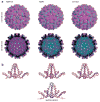The Structural Biology of Hepatitis B Virus: Form and Function
- PMID: 27482896
- PMCID: PMC5646271
- DOI: 10.1146/annurev-virology-110615-042238
The Structural Biology of Hepatitis B Virus: Form and Function
Abstract
Hepatitis B virus is one of the smallest human pathogens, encoded by a 3,200-bp genome with only four open reading frames. Yet the virus shows a remarkable diversity in structural features, often with the same proteins adopting several conformations. In part, this is the parsimony of viruses, where a minimal number of proteins perform a wide variety of functions. However, a more important theme is that weak interactions between components as well as components with multiple conformations that have similar stabilities lead to a highly dynamic system. In hepatitis B virus, this is manifested as a virion where the envelope proteins have multiple structures, the envelope-capsid interaction is irregular, and the capsid is a dynamic compartment that actively participates in metabolism of the encapsidated genome and carries regulated signals for intracellular trafficking.
Keywords: antiviral; capsid; icosahedral; nucleoprotein complex; reverse transcriptase; self-assembly.
Figures






References
-
- Dane DS, Cameron CH, Briggs M. Virus-like particles in serum of patients with australia-antigen-associated hepatitis. Lancet. 1970;1(7649):695–98. - PubMed
-
- Ott JJ, Stevens GA, Groeger J, Wiersma ST. Global epidemiology of Hepatitis B Virus infection: new estimates of age-specific HBsAg seroprevalence and endemicity. Vaccine. 2012;30(12):2212–19. - PubMed
-
- Ni Y-H, Huang L-M, Chang M-H, Yen C-J, Lu C-Y, et al. Two decades of universal Hepatitis B vaccination in Taiwan: impact and implication for future strategies. Gastroenterology. 2007;132(4):1287–93. - PubMed
Publication types
MeSH terms
Substances
Grants and funding
LinkOut - more resources
Full Text Sources
Other Literature Sources

